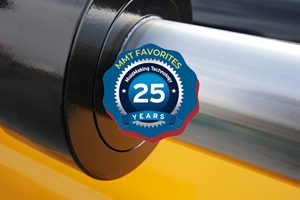Understanding Hot Tip Design
Alternative designs are available that will either eliminate or dramatically reduce skewing the flow of plastic.
While sampling a hot-to-cold-runner mold, a particular shop was fighting variations that appeared to be related to steel imbalances. It was difficult to show any variations in the actual steel that related to the data collected, but during a color change, operators noticed a few colored streaks in the runner following the hot tip. These streaks were very specific in location and consistency.
Around the same time, another shop was experiencing variations in filling and part quality. After evaluating its data, this shop also looked at the mold steel for variations, but again no glaring evidence pointing to the culprits was found. However, similar streaking was noticed in the hot sprue.
In contemplating the influence of the hot tip design, the second shop turned the hot sprue to three different orientations and made short shots of the runner system at each orientation. The results of this test, shown in Figure 1, confirmed the shop’s suspicion that the hot tip was skewing the plastic flow and causing variations in part quality.
Fortunately, alternative hot tips are available that will either eliminate or dramatically reduce skewing the flow of plastic. The hot tip for the mold in Figure 1 was retrofitted with one of those options, and the filling variations and associated problems were immediately eliminated.
The solutions are not always that simple, however. Some alternate hot tip designs come with their own set of challenges. For example, some are more expensive than conventional tips, while others may create other challenges in processing certain materials. Understanding hot tip design and its role in processing quality parts is essential to selecting the most effective solution for your application.
Let’s take the variation shown in Figure 1 and increase it by the number of drops in a multi-drop hot runner system. There is a very high likelihood that each hot tip in that system is in a different orientation relative to the part and/or cold runner sections. If the hot runner system is feeding a cold runner system, each cold runner section could be filling differently, causing the parts also to fill and pack differently, which ultimately leads to increased process and part quality issues.
If the hot runner system is direct-feeding parts, then skewed filling patterns inside the cavities may cause the parts to be dimensionally different from each other or to warp differently. The filling pattern has a direct influence on orientation, packing profiles and shrinkage within each cavity, so if their filling patterns are different, the molded parts are likely to be different.
Lastly, consider the case in which you take a mold that has been running well out of the machine for routine maintenance and cleaning. The hot sprue or hot drops are removed, cleaned and then reinstalled in the hot runner system, but most likely in a different orientation than they were originally. After the mold is put back into operation, you find that the parts are not filling the same and therefore quality control personnel are unhappy. Everyone says nothing changed: “All we did was clean the mold!” Sound familiar? Understanding hot tip design will help identify a solution.
Related Content
It Starts With the Part: A Plastic Part Checklist Ensures Good Mold Design
All successful mold build projects start with examining the part to be molded to ensure it is moldable and will meet the customers' production objectives.
Read MoreRevisiting Some Hot Runner Fundamentals
What exactly does a hot runner do? If you’ve been in the injection molding industry for any length of time, you might think the answer is obvious, but it is not.
Read MoreHow to Correctly Size a Hydraulic Cylinder
This week Randy shares steps for correctly sizing a hydraulic cylinder on a mold.
Read MoreMold Design Review: The Complete Checklist
Gerardo (Jerry) Miranda III, former global tooling manager for Oakley sunglasses, reshares his complete mold design checklist, an essential part of the product time and cost-to-market process.
Read MoreRead Next
Are You a Moldmaker Considering 3D Printing? Consider the 3D Printing Workshop at NPE2024
Presentations will cover 3D printing for mold tooling, material innovation, product development, bridge production and full-scale, high-volume additive manufacturing.
Read MoreHow to Use Continuing Education to Remain Competitive in Moldmaking
Continued training helps moldmakers make tooling decisions and properly use the latest cutting tool to efficiently machine high-quality molds.
Read MoreHow to Use Strategic Planning Tools, Data to Manage the Human Side of Business
Q&A with Marion Wells, MMT EAB member and founder of Human Asset Management.
Read More




















